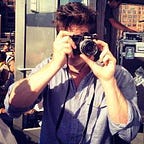Bright Like Neon Love
Why does LA have such an enduring love affair with neon?
I f your expectations of LA have been shaped by Raymond Chandler novels, film noir and L.A Confidential, walking around after dark here can bring on a sense of creeping dread.
It’s a city of wide streets, limited pedestrians, and shifty-looking car-parks which are largely empty at night. As someone who used to quite happily walk around in East London at 2 or 3 in the morning, there is very little to warm the heart of the casual wanderer here.
This, perhaps, explains The City of Angels’ deep, enduring love affair with neon. The slogan for LA movie par-excellence Nightcrawler claimed that ‘The city shines brightest at night’, and they weren’t wrong. Like its scented jasmine plants that only come into full flower after sunset, Los Angeles is a city that blooms at night.
Every great global city has its urban and architectural symbols: London has its tube signs and blue plaques, Tokyo its bewildering variety of inanimate objects that have been given faces and personality, Paris its obsessively beautiful & filigreed Metro signs. LA has neon.
This hard-on for neon extends to the point where, like so many things in this city, it has elevated something deemed trashy and shallow elsewhere, into close to an artform — a truth cemented by the fact that in Pasadena, there is an entire museum devoted to neon art. Even churches in this city offer the promise of forgiveness and salvation in glowing light.
LA is so aggressively & excessively lit — both with neon and streetlights — that it gives off a luminous glow that blots out the stars, and after an earthquake in 1994 people began to call 911 due to the visible & ominous presence in the sky above LA of a large, silvery cloud that had suddenly appeared overhead.
The cloud was The Milky Way, which many Angelenos had never set eyes on before due to the intensity of the glow that the neon-lit city radiates out into the night.
It would be easy, too easy, to use LA’s love of neon as a metaphor for its stereotypical affinity for the radiant, gaudy and artificial, as bright shining proof of the shallowness that has earned mention in every single despatch & cliché written about the city since time immemorial.
It might be simple to equate the city’s predilection for an inert gas that glows in the dark as evidence of the emptiness that many people find in the concrete and highways and strip malls of this sprawling city without a centre.
It would be tempting, even, to suggest that the lights of Los Angeles are a trick or a trap, just a method of attracting people foolish enough to be drawn by shiny things to a place that will burn their wings off like moths flown too close to flame.
I will not be doing any of that.
Paris might be The City of Lights, but The Neon Metropolis is beautiful at night— over the course of a couple of years I have come to feel real affection for the 1000-watt smile it only flashes after dark.
The firing up of neon signage along the strips where LA’s naughtiest misbehaviour occurs is almost a form of traffic light, a way of signalling to the citizens of the world’s most car-centric city that the day is over and now the real fun can begin using a visual language they all understand.
You can look down from the hills, after dark, and see the city lit up, not just the inevitable rivers of red brakelights & white headlights on the freeways, but neon flags up on poles all over the city, promising drinks, food, company, and services even though the stores that they’re advertising are closed. You start to appreciate the glowing mastheads as totem poles, navigating posts lighting the runway home on the dark nights in the city.
Particularly when viewed from above, it feels like you are watching the hidden paths and tracks of this giant sprawling mess, the hidden stories and lives of its citizens as they go about their day and intersect here and there, each being mapped and given a glowing vapour trail that only lasts until sundown.
There are plenty of good reasons why Los Angeles seems so 0ver-committed to neon — the city’s urban design around freeways meaning that restaurants, bars and shops need to advertise themselves brightly to be seen at distance, the sinister and sprawled-out emptiness of it requiring extra light to make its citizens feel safe, the fact that neon just looks fucking cool in the dark and Angelenos love things that look cool — but none of these careful rationalizations quite capture the romance of the moment when the sun sets and the city catches fire.
Perhaps Los Angeles, the entertainment factory that manufactures fame on a global scale, will permit no competition, will not let anything, even celestial bodies, shine brighter than the stars that are its biggest export.
Maybe, just maybe, the city that people first came to because of the glorious, golden quality of its light, doesn’t ever want to let the sun go down, just will not allow the glow to die, and has tried to bottle it in the only way its knows how.
